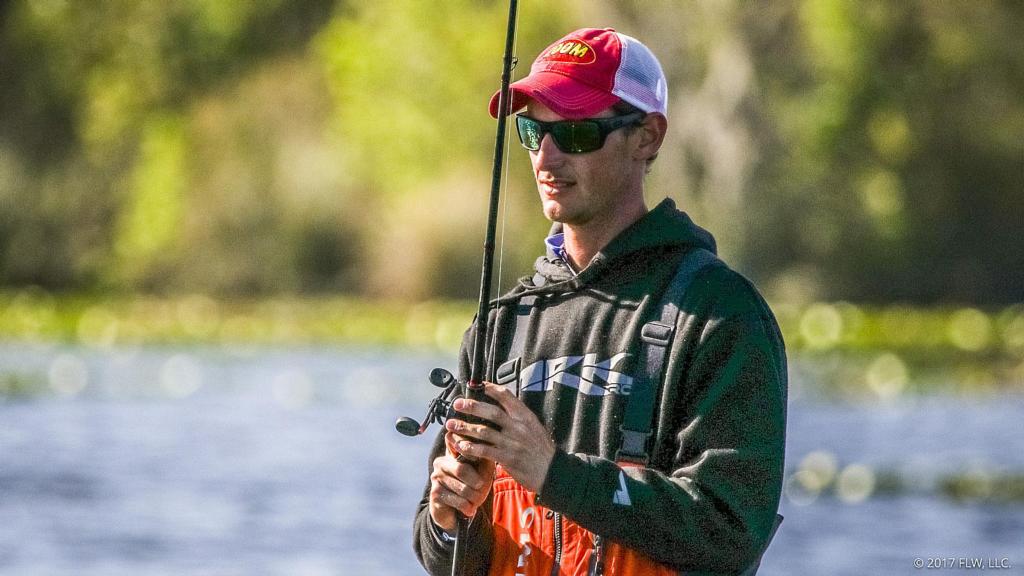Brandon Cobb’s Top 5 Spring Tips
Five tips to catch more and bigger bass this spring

Brandon Cobb can catch bass most any way, but in tournaments he’s most often found shallow, running along the bank looking for keeper bass. Spring is the best time of year for shallow fishing, and Cobb’s spring results back that up. He’s in his prime when the weather is warming and the bass are coming to him. With that in mind, we picked the young South Carolina pro’s brain for some insight on how to catch ’em better in the spring.
1. Big fish move up early
“Big fish always move up before anybody thinks they do,” says Cobb. “Most of your fish anywhere in the country are coming from the main lake. So, I always try to start in small main-lake pockets; places where they aren’t event trying to stage, but they just want to be able to get shallow.”
In addition to looking at small pockets, Cobb also likes trying the mouths of larger creeks. Additionally, Cobb says that the big-fish-move-first theory applies all through the spring. If you like to sight-fish, the first wave to hit the beds is generally comprised of the biggest bass.
2. There are more than you think
“Generally, if you catch fish in the spring there are a lot more there than you think,” he says. “Fish tend to congregate more in the immediate prespawn. Like at the place I ended up catching probably 60 percent of my fish at Guntersville [for the 2017 Tour opener]. I got one or two bites in practice and thought it was decent, but I didn’t realize what was here until I slowed down.”
Cobb says that catching multiple fish off a prespawn bank or transition is nothing out of the ordinary, but he’ll give docks and smaller places a chance to produce extra as well. Usually, he goes back down productive stretches with the same bait, often a crankbait of some kind, and doesn’t slow down to re-fish areas until he’s sure there are a few bass there.
3. Timing is key
“I’ve seen it hundreds of times. When fish first come up on beds, you can go look for two hours in the morning and not see any. But if you go back to the bank at 3 o’clock they might be there,” says Cobb. “It’s not for sure, but they can flood the bank in a hurry in hours this time of year. When they come, they come. It might not even be that they are on beds. Sometimes they just go to the bank in the afternoon.
4. Don’t be afraid to go slow
When he starts reading 55 degrees on his graphs, Cobb likes to start looking for spawning bass. That can make for a lot of trolling motor time in practice, but he plays things differently on derby day.
“In practice I look at 100 percent [trolling motor power], but in the tournament I don’t like to,” says Cobb. “So many fish caught in spawning tournaments may be on beds, but they bite before they know you are there. So if I’m looking in the tournament I try to go slow enough to where I can still fish effectively.”
5. Bring a wacky rig
“There are a lot of baits that I throw a lot, but there’s nowhere in the country you can’t catch them on a wacky rig,” says Cobb. “If the fish are prespawn, spawning or postspawn I always have a wacky-rigged Zoom Fluke Stick tied on. I rarely nail weight it, but sometimes I’ll put it on a flick shake-style head, and sometimes I will fish it unweighted.”
Cobb says that on lakes with flat banks, he prefers unweighted rigs. On lakes with steeper banks, he’s more apt to use the flick shake.
When he does weight it, Cobb says he rarely goes heavier than 1/8 ounce, and will sometimes change to a normal shaky head if having a heavier weight is important. For color, he sticks with green pumpkin everywhere but Florida. The dark water of the Sunshine State calls for black and blue.